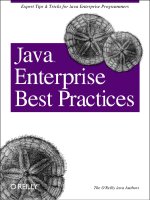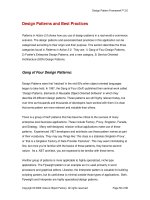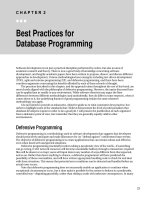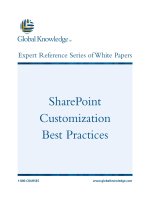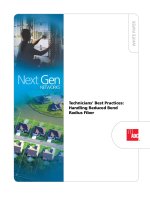Liferay portal performance best practices
Bạn đang xem bản rút gọn của tài liệu. Xem và tải ngay bản đầy đủ của tài liệu tại đây (2.09 MB, 150 trang )
www.it-ebooks.info
Liferay Portal Performance
Best Practices
A practical tutorial to learn the best practices for
building high performing Liferay-based solutions
Samir Bhatt
BIRMINGHAM - MUMBAI
www.it-ebooks.info
Liferay Portal Performance Best Practices
Copyright © 2013 Packt Publishing
All rights reserved. No part of this book may be reproduced, stored in a retrieval
system, or transmitted in any form or by any means, without the prior written
permission of the publisher, except in the case of brief quotations embedded in
critical articles or reviews.
Every effort has been made in the preparation of this book to ensure the accuracy
of the information presented. However, the information contained in this book is
sold without warranty, either express or implied. Neither the author, nor Packt
Publishing, and its dealers and distributors will be held liable for any damages
caused or alleged to be caused directly or indirectly by this book.
Packt Publishing has endeavored to provide trademark information about all of the
companies and products mentioned in this book by the appropriate use of capitals.
However, Packt Publishing cannot guarantee the accuracy of this information.
First published: June 2013
Production Reference: 1030613
Published by Packt Publishing Ltd.
Livery Place
35 Livery Street
Birmingham B3 2PB, UK.
ISBN 978-1-78216-368-8
www.packtpub.com
Cover Image by Faiz Fattohi ()
www.it-ebooks.info
Credits
Author
Project Coordinator
Samir Bhatt
Sneha Modi
Reviewers
Proofreader
Gaurav Barot
Maria Gould
Albert Coronado Calzada
Indexer
Chintan Mehta
Hemangini Bari
Acquisition Editor
Graphics
Kartikey Pandey
Abhinash Sahu
Commissioning Editor
Harsha Bharwani
Technical Editors
Jalasha D'costa
Amit Ramadas
Production Coordinator
Aditi Gajjar
Cover Work
Aditi Gajjar
www.it-ebooks.info
About the Author
Samir Bhatt is an Enterprise Architect with over 12 years of IT experience. He
has been working on Liferay-Portal-based solutions for the last four years. He has
co-authored a book, Liferay Beginner's Guide by Packt Publishing. He is also a Liferay
certified trainer and has delivered public and private training across the world.
Samir leads an architectural group at CIGNEX Datamatics. He extensively worked
on performance tuning of Liferay-Portal-based solutions. Apart from Liferay Portal,
Samir has also worked on many other technologies and frameworks including
Hadoop, MongoDB, Pentaho BI, Oracle, Java Swing, ICEfaces, ZK, Spring, Hibernate,
and Visual Basic.
Samir is also a very good speaker and has delivered various webinars on Liferay,
Pentaho BI, and MongoDB. He blogs at www.connect-sam.com.
I would like to specially thank my mentor and CTO of CIGNEX
Datamatics, Munwar Sharif, for encouraging me to write this book.
I sincerely thank the entire Packt Publishing team for providing
continuous support throughout this project.
Last but not least, I would like to give a big thanks to my parents,
my wife Hetal, and my little daughter Shreeya for supporting and
encouraging me throughout the project.
www.it-ebooks.info
About the Reviewers
Gaurav Barot is a Liferay Architect having 8 years of industry experience, with
more than 4 years of experience in Liferay Portal technologies. He has executed
Liferay projects in various domains such as media, healthcare, insurance, and so
on. He has been involved in the complete life cycle of the project starting from
requirement gathering to deployment. He has worked on various versions of
Liferay from 5.x to 6.1. He is a certified trainer as well and has provided more
than 15 successful private and public training sessions to more than 100 trainees
across the globe.
He works with CIGNEX Datamatics, which is a global leader in Open Source
technologies. He leads Liferay Practice having nearly 200 members at his organization.
Gaurav also co-authored Liferay Beginner's Guide by Packt Publishing.
I would like to thank my parents and my two younger sisters, Kinjal
and Yogini, for their love and encouragement. A special thanks to
my wife Kruti and my lovely daughter Twisha; both of them have
been very tolerant and understanding during all the time I've spent
on the computer while reviewing this book.
www.it-ebooks.info
Albert Coronado Calzada is a highly experienced IT professional with more
than 13 years of experience in Java EE, high performance portals, e-commerce,
and enterprise software solutions. Albert has completed his Engineering degree
in Information Technology and has pursued a Master's in Economic and Financial
Management of Companies.
Albert is currently working as a freelance software developer, technical trainer, and
consultant for international customers. Albert is an open source software contributor
and has released different applications for Liferay and Android.
Albert has also worked on Liferay Beginner's Guide and Instant Liferay Portal 6 Starter
by Packt Publishing.
Albert lives in Girona (Spain) and maintains a blog at http://www.
albertcoronado.com. You can contact him through Linkedin (es.linkedin.com/
in/albertcoronado/) or Twitter (@acoronadoc).
Chintan Mehta has over 10 years of progressive experience in Systems and Server
Administration of Linux and open source technologies, along with applications such
as Liferay, Alfresco, Drupal, Moodle, Magento, and Compiere. While developing
his expertise in these areas, he also enhanced his technical skills in database
administration, security, and performance tuning. He heads the Managed Cloud
Services practice at CIGNEX Datamatics, and is involved in creating solutions
and consulting customers on the cloud. Chintan has done Diploma in Computer
Hardware and has a Network certification from a reputed institute in India.
www.it-ebooks.info
www.PacktPub.com
Support files, eBooks, discount offers and more
You might want to visit www.PacktPub.com for support files and downloads related
to your book.
Did you know that Packt offers eBook versions of every book published, with PDF
and ePub files available? You can upgrade to the eBook version at www.PacktPub.
com and as a print book customer, you are entitled to a discount on the eBook copy.
Get in touch with us at for more details.
At www.PacktPub.com, you can also read a collection of free technical articles, sign
up for a range of free newsletters and receive exclusive discounts and offers on Packt
books and eBooks.
TM
Do you need instant solutions to your IT questions? PacktLib is Packt's online
digital book library. Here, you can access, read and search across Packt's entire
library of books.
Why Subscribe?
• Fully searchable across every book published by Packt
• Copy and paste, print and bookmark content
• On demand and accessible via web browser
Free Access for Packt account holders
If you have an account with Packt at www.PacktPub.com, you can use this to access
PacktLib today and view nine entirely free books. Simply use your login credentials
for immediate access.
www.it-ebooks.info
www.it-ebooks.info
Table of Contents
Preface1
Chapter 1: Architectural Best Practices
7
The Liferay Portal reference architecture
The Presentation tier
The Networking tier
The Web tier
The Application tier
The Database Repository tier
The Search Repository tier
The Media Repository tier
The Active Directory tier
Reference architecture characteristics
7
9
9
9
9
10
10
10
10
10
The Deployment sizing approach
The reference hardware
The performance benchmark test summary
An example of sizing calculations
12
13
14
15
The Documents and Media Library architecture
File System and Advanced File System stores
The Database store
The JCR store
The CMIS store
The S3 store
The database architecture
The read/write database
15
16
16
17
17
18
18
18
Scalability11
Performance11
High availability and fault tolerance
11
Security11
Sample performance requirements
Sizing calculations
www.it-ebooks.info
15
15
Table of Contents
Database sharding
Static content delivery
Content Delivery Network
Content delivery through the web server
The caching architecture
Caching using Ehcache
19
20
21
21
22
22
Caching using Terracotta
Web resource caching using Varnish
The search architecture
Apache Lucene
24
25
26
26
Ehcache replication using RMI
Ehcache replication using Cluster Link
Index storage on SAN
Lucene Index replication using Cluster Link
22
23
26
27
Apache Solr
27
Summary29
Chapter 2: Load Balancing and Clustering Best Practices
The basics of load balancing and clustering with Liferay
Setting up Liferay Portal nodes
Software load balancer configuration using the Apache Web Server
Load balancer configuration using mod_jk
Load balancer configuration using mod_proxy_ajp
Load balancer configuration using mod_proxy_http
Load balancing best practices
Liferay Portal cluster configuration
Session replication configuration
Cache replication
Ehcache replication using RMI
Ehcache configuration using JGroups
Ehcache replication using Cluster Links
Ehcache clustering best practices
31
32
33
35
35
37
39
41
41
42
44
45
46
47
47
Media Library configuration
48
Search engine configuration
53
Network file storage using the Advanced File System store
Database storage using the JCR store
Database storage using DBStore
Media Library clustering best practices
Lucene index storage on network storage
Lucene index replication using Cluster Link
Using the Apache Solr search engine
Clustering best practices for the search engine
48
49
52
52
53
54
54
56
Quartz scheduler configuration
56
Summary57
[ ii ]
www.it-ebooks.info
Table of Contents
Chapter 3: Configuration Best Practices
Liferay Portal configuration best practices
Servlet filter configuration
The auto login filter
The CAS filter
The NTLM SSO filter
The OpenSSO filter
The SharePoint filter
The GZip filter
The Strip filter
The ValidHtml filter
Auto login hooks
Counter increment
User session tracker
Direct Servlet Context
Plugin repositories
Pingbacks and trackbacks
Google's blog search ping integration
The asset view counter
Document ranks and view count
Scheduler configuration
Inline permission checks
Lucene Configuration
Application Server configuration best practices
Database connection pool configuration
JVM configuration
Garbage Collection
The Java Heap configuration
59
60
60
60
61
61
61
62
62
62
63
63
63
64
64
65
65
66
66
66
67
69
70
70
70
72
72
73
JSP engine configuration
74
Thread pool configuration
75
Apache Web Server configuration best practices
76
Static content delivery
76
GZip compression configuration
78
Cache header configuration
79
Apache Web Server MPM configuration
80
Summary81
Chapter 4: Caching Best Practices
83
Customizing the Ehcache configuration
83
Hibernate Ehcache CacheManager
85
Single-VM CacheManager
86
Multi-VM CacheManager
86
Ehcache configuration best practices
86
Caching using Terracotta
89
Summary92
[ iii ]
www.it-ebooks.info
Table of Contents
Chapter 5: Development Best Practices
93
UI best practices
93
Reducing the number of JavaScript files
94
Reducing the number of CSS files
96
Using CSS image sprites
96
Minifying JavaScript files
98
JavaScript positioning
99
Limiting the use of DOM operations
100
Analyzing web page performance using tools
100
Portlet development best practices
101
Limiting the use of dynamic queries
101
Liferay caching API
102
Coding best practices
103
Summary103
Chapter 6: Load Testing and Performance Tuning
Getting ready for load testing
Capturing load testing requirements
Selecting load testing tools
105
106
106
107
Apache JMeter
107
BlazeMeter107
Apache Benchmark (ab)
108
Preparing load testing scripts
Setting up the load testing environment
Conducting load tests
Resource monitoring and performance tuning
Liferay Portal server – monitoring and tuning
108
110
110
111
111
Apache web server – monitoring and tuning
Monitoring the database server
123
124
JConsole111
VisualVM113
JVM – monitoring and tuning
114
Tomcat thread – monitoring and tuning
117
Database connection pool – monitoring and tuning
119
Cache – monitoring and tuning
121
CPU and memory usage
124
Slow queries
124
Connections125
Lock monitoring
125
Monitoring logfiles
125
Summary126
Index127
[ iv ]
www.it-ebooks.info
Preface
Liferay is the most popular portal based on open standards, written in Java. It
was named Leader in Gartner's Magic Quadrant for Horizontal Portals. Many
influential sites have been implemented with or have switched to Liferay Portal.
The Liferay platform is highly scalable to serve millions of pages to millions of users
on all web browsers, tablets, and mobile devices. We, at CIGNEX Datamatics, have
implemented more than 200 large enterprise portals using Liferay since 2006. I was
leading Liferay Practice at CIGNEX Datamatics with a staff of 240 Liferay experts.
We have tuned many Liferay-based sites, and also trained many administrators
and developers in Liferay. This book distills the hands-on approach of my project
engagements into a concise, practical book.
Liferay Portal Performance Best Practices will explain to you how to implement
high-performing, Liferay-based solutions by following various best practices.
The book not only explains the best practices in detail, but also provides the
detailed instructions to implement them. By following the logical flow of the
chapters, you will learn performance-related best practices that should be
followed during the architecture, design, development, deployment, and testing
phases. You will also learn best practices for conducting performance tuning
activities for a Liferay-based solution. By the end of this book you will have the
advanced knowledge to implement a high-performing, Liferay-based solution.
What this book covers
Chapter 1, Architectural Best Practices, talks about the Liferay Portal reference
architecture. It talks about various architectural options for implementing
high-performing, Liferay-based solutions.
Chapter 2, Load Balancing and Clustering Best Practices, teaches you how to implement
load balancing and clustering for a Liferay-based solution. It teaches you about
various configuration options for implementing clustering.
www.it-ebooks.info
Preface
Chapter 3, Configuration Best Practices, teaches you various configurations for
improving performance of Liferay-based solutions. It talks about performance-related
configuration options for the Apache web server, the Tomcat server, Liferay Portal,
and so on.
Chapter 4, Caching Best Practices, talks about various options related to caching for
improving the performance of Liferay-based solutions. It also teaches you how to
configure Liferay Portal with the Terracotta cache server.
Chapter 5, Development Best Practices, talks about some of the key Liferay-specific
development practices for developing a high-performing, Liferay-based solution.
Chapter 6, Load Testing and Performance Tuning, teaches you how to perform load
testing and performance tuning exercises for a Liferay-based solution. It talks about
best practices and guidelines related to load testing and performance tuning. It talks
about how to monitor various resources during a load testing exercise in order to
fine-tune the solution.
What you need for this book
The following is the software that you will need for Liferay Portal Performance
Best Practices.
• Liferay Portal 6.1 CE GA2 Tomcat Bundle (http://downloads.
sourceforge.net/project/lportal/Liferay%20Portal/6.1.1%20GA2/
liferay-portal-tomcat-6.1.1-ce-ga2-20120731132656558.zip)
• Apache Web Server 2.x ( />• MySQL Community Server 5.5.29 ( />• Terracotta Server Array, with Ehcache and Quartz (http://terracotta.
org/downloads/open-source/destination?name=terracotta-3.7.5installer.jar&bucket=tcdistributions&file=terracotta-3.7.5installer.jar)
Who this book is for
Developers and architects who already work on Liferay Portal will find this book
very useful. Also, system administrators who administer Liferay-Portal-based
solutions will find this book very useful.
[2]
www.it-ebooks.info
Preface
Conventions
In this book, you will find a number of styles of text that distinguish between
different kinds of information. Here are some examples of these styles, and an
explanation of their meaning.
Code words in text are shown as follows: "Instead of using SingleVMPoolUtil,
we will need to use the MultiVMPoolUtil class to store and retrieve objects from
the cache."
A block of code is set as follows:
/arrows/01_down.png=0,16,16
/arrows/01_left.png=16,16,16
/arrows/01_right.png=32,16,16
/arrows/01_up.png=48,16,16
When we wish to draw your attention to a particular part of a code block, the
relevant lines or items are set in bold:
package com.connectsam.development;
import com.liferay.portal.kernel.cache.SingleVMPoolUtil;
import java.util.ArrayList;
import java.util.List;
public class SingleVMPoolExample {
public List<String> getTestList(String key){
List<String> listOfStrings = null;
New terms and important words are shown in bold. Words that you see on
the screen, in menus or dialog boxes for example, appear in the text like this:
"In JConsole, navigate to the MBeans tab and then expand net.sf.ehcache |
CacheStatistics | liferay-multi-vm-clustered."
Warnings or important notes appear in a box like this.
Tips and tricks appear like this.
[3]
www.it-ebooks.info
Preface
Reader feedback
Feedback from our readers is always welcome. Let us know what you think about
this book—what you liked or may have disliked. Reader feedback is important for
us to develop titles that you really get the most out of.
To send us general feedback, simply send an e-mail to ,
and mention the book title via the subject of your message.
If there is a topic that you have expertise in and you are interested in either writing
or contributing to a book, see our author guide on www.packtpub.com/authors.
Customer support
Now that you are the proud owner of a Packt book, we have a number of things to
help you to get the most from your purchase.
Errata
Although we have taken every care to ensure the accuracy of our content, mistakes
do happen. If you find a mistake in one of our books—maybe a mistake in the text
or the code—we would be grateful if you would report this to us. By doing so,
you can save other readers from frustration and help us improve subsequent
versions of this book. If you find any errata, please report them by visiting http://
www.packtpub.com/submit-errata, selecting your book, clicking on the errata
submission form link, and entering the details of your errata. Once your errata
are verified, your submission will be accepted and the errata will be uploaded on
our website, or added to any list of existing errata, under the Errata section of that
title. Any existing errata can be viewed by selecting your title from http://www.
packtpub.com/support.
Piracy
Piracy of copyright material on the Internet is an ongoing problem across all media.
At Packt, we take the protection of our copyright and licenses very seriously. If you
come across any illegal copies of our works, in any form, on the Internet, please
provide us with the location address or website name immediately so that we can
pursue a remedy.
[4]
www.it-ebooks.info
Preface
Please contact us at with a link to the suspected
pirated material.
We appreciate your help in protecting our authors, and our ability to bring you
valuable content.
Questions
You can contact us at if you are having a problem with
any aspect of the book, and we will do our best to address it.
[5]
www.it-ebooks.info
www.it-ebooks.info
Architectural Best Practices
The most important aspect that affects the performance of a system is architecture. It
is often seen that systems fails to perform as expected because of wrong architectural
decisions. Liferay is a leading open source platform for developing high-performing
portals. In this chapter, we will focus on the architecture of Liferay-Portal-based
solutions. We will learn about various aspects which should be considered while
defining the architecture of a Liferay-based solution. By the end of this chapter, we
will learn about:
• The Liferay Portal reference architecture
• The Deployment sizing approach
• Documents and Media Library architecture options
• Database architecture options
• Architectural options for handling static resources
• Caching architecture options
• Search engine architecture options
The Liferay Portal reference architecture
Defining the architecture of a system from scratch requires an enormous amount of
effort for researching, investigating, and taking right architectural decisions. We
can reduce the effort by referring to the reference architecture for similar kinds
of solutions. We can also ensure including a set of architectural best practices
from the reference architecture. In this section, we will talk about the reference
architecture of Liferay-Portal-based solution. This reference architecture can be
used as a base for any Liferay-Portal-based portal solution. Of course, necessary
changes have to be made in the reference architecture depending upon specific
requirements. The rest of the chapter will help Liferay architects to make the right
architectural decisions for such changes.
www.it-ebooks.info
Architectural Best Practices
Here is the reference architecture diagram of Liferay-Portal-based solution:
Users
Mobile
Devices
Tablets
Computers
Firewall
Hardware
Load Balancer
Apache
Web Server 1
+
Software
Load Balancer
Apache
Web Server N
+
Software
Load Balancer
Network
Tomcat
Application Server 1
Tomcat
Application Server 2
Tomcat
Application Server N
Netwrok
Database
Server 1
Database
Server N
Active Directory
Server
Media Repository
(Storage Area
Network)
Lucene
Search Index
Repository for
App Server 1
Clustered Database Repository
Lucene
Search Index
Repository for
App Server 2
Search Repository
[8]
www.it-ebooks.info
Lucene
Search Index
Repository for
App Server N
Chapter 1
The Presentation tier
As shown in the previous diagram, users of the portal will access the Portal
using tablets, mobile devices, or through PC browsers. Liferay Portal 6.1 supports
various devices, and we won't need any special component to render content for
mobile devices. Liferay Portal can even detect specific devices and respond with
device-specific content. Liferay also supports creating responsive web design using
its UI framework called AlloyUI.
The Networking tier
As shown in the reference architecture, every request will pass through Firewall.
Firewall will filter unsecure requests. All valid user requests will be passed to the
Hardware Load Balancer. The hardware load balancer is a hardware appliance
which distributes loads between multiple web servers. The hardware load balancer
can also deal with the failure of web servers. In case a of failure of any web server,
the hardware load balancer diverts traffic to working web servers. There are a number
of hardware load balancers available on the market. Some of the popular hardware
load balancer vendors include F5, Cisco, Radware, CoyotePoint, and Barracuda.
The Web tier
The Web tier includes a series of Apache Web Servers. As shown in the reference
architecture diagram, each Web Server is connected with each Application Server.
The Web Server acts as a Software Load Balancer for Application Servers. Web
servers can also act as components to serve static resources. The Apache Web Server
connects with the Liferay Portal application server using mod_jk, mod_proxy, or
mod_proxy_ajp connectors. These are popular connecters available with the Apache
Web Server.
The Application tier
The Application tier includes one or more Liferay Portal application servers.
Liferay Portal can be deployed on many different application servers. The reference
architecture recommends using the most popular Apache Tomcat Server. Application
servers are connected with web servers using the AJP protocol or the HTTP protocol.
As shown in the diagram, there is a communication link between Application Servers.
Each Application Server is connected with other Application Servers to replicate the
session information, and cache and/or search indexes. Each Application Server is
connected to dedicated Database Servers and Active Directory Servers.
[9]
www.it-ebooks.info
Architectural Best Practices
The Database Repository tier
The Liferay Portal server connects to the Database Repository tier. For production
systems, it is advisable to set up multiple database instances with replication. Such
a setup ensures high availability of Database Servers. Liferay Portal works with
majority of open source and propriety databases. In our reference architecture,
we will use MySQL, which is one of the popular open source databases.
The Search Repository tier
Liferay Portal comes with an embedded Apache Lucene search engine. The Lucene
search engine stores search indexes in a filesystem. As shown in the reference
architecture diagram, each Application Server has its own search index repository
in the Search Repository tier. Search engine repositories can be synchronized by
the Liferay Portal server using the Cluster Link feature.
The Media Repository tier
Liferay Portal comes with a media repository, which includes a document library,
image gallery, and so on. Liferay Portal provides different options to store the media
repository content. By default, Liferay stores the media repository content on a
filesystem. It can be configured to store the media repository content on a database,
Java Content Repository (JCR), CMIS-based repository, or Amazon S3. As shown in
the reference architecture diagram, we have used a centralized filesystem to store the
media repository content. To avoid issues related to concurrent access on a centralized
filesystem, it is recommended to use Storage Area Network (SAN) as the centralized
filesystem to store the Media Library content.
The Active Directory tier
Liferay comes with its own user repository. Liferay maintains its user repository
in a database. But for production systems, it is recommended to integrate the user
repository with identity management systems. The reference architecture refers
using the Active Directory server. Liferay Portal connects with the Active Directory
Server using the LDAP protocol.
Reference architecture characteristics
In the previous section, we learned about various tiers of the reference architecture.
Let's understand how the reference architecture addresses architectural concerns.
[ 10 ]
www.it-ebooks.info
Chapter 1
Scalability
As shown in the architecture diagram, horizontal scaling is used for both the
Web tier and the Application tier. Most of the components in the architecture are
decoupled and hence if the user base is increased, we can scale up by adding extra
nodes. We can establish linear scalability of the solution by using a performance
benchmarking exercise. This can enable us to increase the capacity of the system by
increasing 'x' number of Liferay application servers, web servers, or database servers.
Performance
The reference architecture divides the load of the system to multiple tiers. A static
resource's requests can be served by the Web tier directly. Also, the Web tier is load
balanced using the Hardware Load Balancer. So, the load on each web server is
also controlled. Similarly, all application requests will be served by the clustered
Application Server tier. The Application Server connects with the Database tier which
is again clustered to ensure the load is distributed. The reference architecture ensures
that the architecture of the solution is robust enough for delivering high performance.
High availability and fault tolerance
The reference architecture ensures that the most important tiers of the solutions are
clustered and load balanced to ensure that the system is highly available and fault
tolerant. As shown in the diagram, the Web tier, Application tier, and Database tier
are clustered, which means that if any nodes from these tiers go down, the system
will still respond to user requests.
Security
The reference architecture places Firewall in front of the Hardware Load Balancer,
which ensures that all the security threats are filtered. Depending upon the security
needs, it is advisable to set up a firewall between each tier as well. So for example,
the Web tier can access the Application tier, but the opposite can be prevented.
Depending upon the project need, the architecture supports configuring
SSL-based access.
[ 11 ]
www.it-ebooks.info
Architectural Best Practices
The Deployment sizing approach
In the previous section, we learned about the Liferay Portal reference architecture.
The reference architecture is generic in nature. It can be used as a reference to define
an architecture that is more specific to a project. One of the important activities in
defining a specific architecture is sizing. We need to be sure of the number of Liferay
Portal application servers or web servers to meet performance expectations. In the
beginning of the project when the system is yet to be developed, it is impossible
to size the architecture with 100 percent accuracy. Hence, the idea is to size the
architecture based on previous benchmarks, and then review the sizing during the
load testing phase when the system is ready. Liferay Inc. publishes the performance
benchmark for every major Liferay Portal release. It is a best practice to use this
benchmark as a reference and size the deployment architecture of the solution. In
this section, we will learn how to size the deployment architecture of the LiferayPortal-based solution based on Liferay's performance benchmark whitepaper.
This section refers to the Liferay Portal 6.1 performance white
paper published by Liferay Inc.. This whitepaper can be
accessed through the following URL:
/>Portal_6.1
The first step of the sizing activity is to capture some of the basic non-functional
requirements. The following table provides a list of these questions. The answers to
these questions will act as parameters for sizing calculations.
No.
The requirement question
Mandatory?
Details
1
How many concurrent users will
log in at the same time?
Yes
Login is the most resourceconsuming use case in Liferay
Portal. It is very important
to know the answer to this
question.
2
What is the number of
concurrent users accessing the
Message Board functionality
including login?
No
The Liferay performance
benchmark report publishes
the result of this scenario.
If the project requirement
matches the scenario, we
can use this to size the
deployment architecture
more accurately.
[ 12 ]
www.it-ebooks.info

